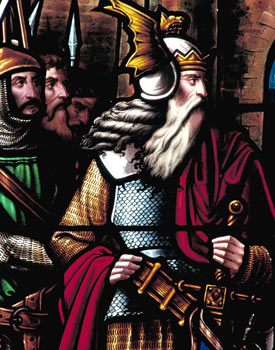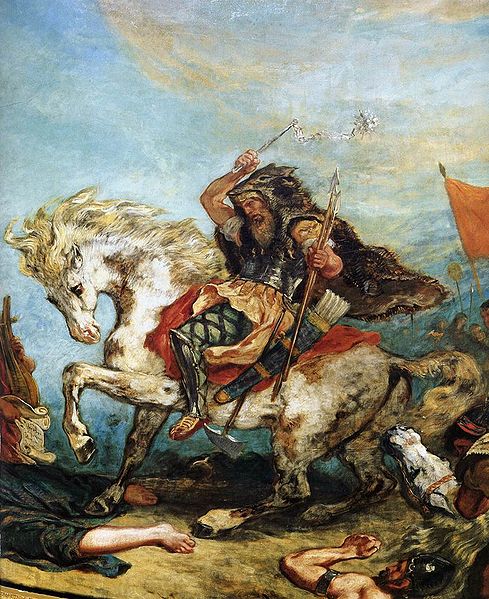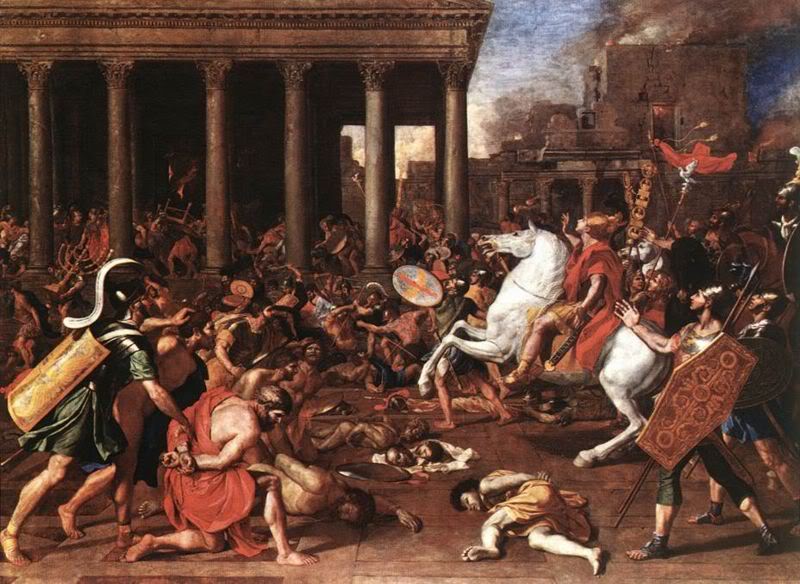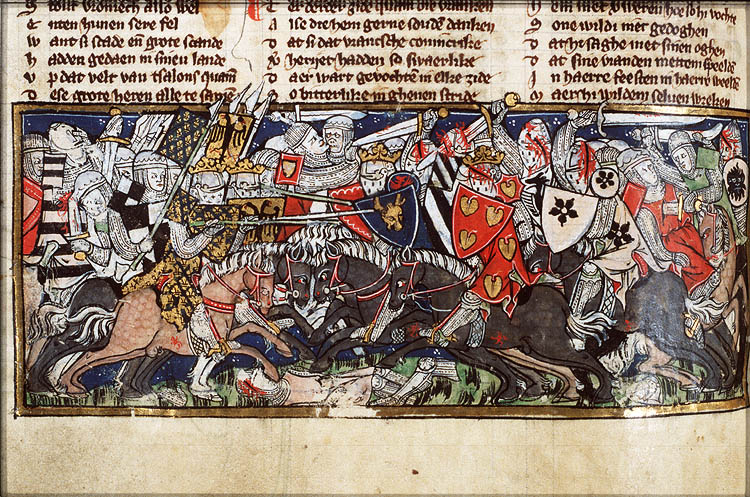They were tribes in quest. The Huns, who initiated the great wave of migrations, likewise did not merit their reputation as savage and implacable enemies of civilization, though they came quite close. After destroying the Gothic kingdom in the Ukraine, they settled down in the region north of the Danube and entered into reasonably good relations with the Roman Empire. They became a serious threat to western Europe only after Attila succeeded to the kingship in 434.
With his motely army, Attila, terrorized the Balkans for the first fifteen years of his reign. But in the middle of the fifth century, at the same time that the Vandals were attacking Italy from the south, Attila invaded the west. Jordanes says he was bribed to do so by Gaiseric, the Vandal king. Attila had also been in touc with the rebellious peasants of Gaul, the Baguadae. He had negotiated with one group of Franks and had received an offer of marriage from Honoria, the sister of Emperor Valentinian III. Honorai would scarcely have sent Attila her ring if she had thought him a savage, filthy, flat-nosed monster from the Steppes; at least in principle.

''The baptism of Clovis in Reims in 496 made him the only barbarian Christian king and won him increased support from his former Roman subjects in Gaul. This romantic recreation of the event was by François-Louis Dejuinne (1786-1844), completed in 1837''
Attila’s raid across the Rhine into gaul was checked by a ”Roman” army consisting of Franks, Burgundians, Visigoths, Sarmatians, Saxons, Bretons, and Alans, under a general, Aetius, who had been raised among the Huns and habitually hired Hunnish mercenaries. It seems hardly likely that the famous Battle of the Catalaunian Plains saved Western Europe from domination by Asiatic nomadism, as the traditional view has it. Attila headed a confederation dominated by Germans, and the battle merely decided which of several different groups of Germans was to rule in Gaul. Nor does the figure given by Jordanes, that 180,000 men fell on both sides of the battle, seem at all likely. Attila’s army was still strong enough to withdraw in good order and invade Italy the following year. Aquilera, Milan, Pavia, and other cities were ravaged or forced to pay tribute. But disease and hunger soon forced the Huns to retreat.

Dr. Peter Heather: ''Attila ruled the Hunnic Empire from 440 to 453 AD, first with his brother Bleda, then alone after he had Bleda murdered. A first-hand account of Atilla by the Roman historian Priscus tells us that he was intelligent and extremely modest in his dress, although capable of violent outbursts of anger.''
The following year Attila died. His body was laid upon a bier in a silken tent in the midst of an open field, and the Huns reverted to their ancient traditions in celebrating the funeral rites of their greatest king. After much riding and singing and an enormous banquet, they buried the dead king in a triple coffin, the first layer of gold, the second of silver, the third of iron. Theyy filled the grave with armor from slain enemies and with precious gems. To protect it from grave robbers, they killed all the workmen, presumably slaves, who had taken part in the burial.
Jordanes reports a similar slaughter after the burial of Alaric; it is probable that the killings also represented an ancient Scythian ritual that the Huns as well as the Goths had brought with them from their residence in Scythia. The Scythians strangled the victims so the king would have servants in the afterlife.

Attila and his Hordes Overrun Italy and the Arts (detail) (1838-1847 Painting by Eugène Delacroix, reproduction from Wikipedia, `Attila the Hun'.)
Michael A. Babcock has written that evidence supports a theory that Attila the Hun did not die on his wedding night of a nosebleed or an alcoholism-induced esophageal rupture.” At least, not unaided.Babcock concludes the Byzantine Emperor Marcian hired assassins to kill Attila.The traditional account of the degrading death of the warrior Attila comes from the Gothic historian Jordanes, writing a century after the event. Jordanes bases his account of Attila’s death on that of Attila’s contemporary Priscus, who had first-hand experience of a cautious, clear-headed Hun leader who did not, in Priscus’ experience, drink to excess.”

Death of Germanicus by Nicolas Poussin. ''Numerous revolts occurred among the Gaulish legions in the service of the Roman Empire in Germany. But the stubborn and trained resistance of the Romans no less than the inexperience of the Gauls led to a cessation of hostilities. The secret of Roman power in Rheni
erritory lay in the circumstance that the two great elements of German nationality, the nobility and the priesthood, were becoming Romanized. But a rude culture was beginning to blossom, and a desire arose among the barbarians for unity''
Attila left a great many sons, who promptly began quarreling among themselves over the inheritance. The subject peoples seized the opportunity to rise in revolt, and soon nothing was left of the ephemeral Hunnish empire.It was at this time, in the middle of the fifth century, after the last of the Roman armies had been withdrawn, that Angles, Saxons and Jutes began pouring into England. Elsewhere, the typical pattern of barbarian movement was that of the Franks, who infiltrated rather than invaded the land that subsequently became France.
Only in Britain was there a true invasion in which the invaders displaced the native population and destroyed its institutions. Everywhere else Roman civilization was elastic enough to absorb the newcomers, although in the process many institutions changed and the empire itself became fragmented.
The great epic of the barbarian migrations, however, remains the adventures of the Ostrogoths in Italy. The Ostrogoths had been split into two parts by the onslaught of the Huns. One group remained in Panonia as sattelites of the Huns and fought loyally on the side of Attila on his expeditions into Gaul and Italy. After Attila’s death they asserted their independence, and in a great battle under a king named Walamar they defeated the Huns. That same day in 455 a son was born to Walamar’s brother. He was named Theoderic, meaning ”ruler of the people” and he was destined to become just that.

''On charges of treason, Theodoric the Great, Ostrogothic ruler of Italy, executes Hellenist and philosopher Anicius Manlius Severinus Boëthius, who had risen to the office of Magister officiorum (head of all government and court services) in Theodoric's court. The execution took place in 524 or 525, possibly because Theodoric suspected Boëthius's involvement in a plot with the Byzantine Emperor Justin I, whose religious orthodoxy, in contrast to Theodoric's Arian opinions, increased their political rivalry. ♦ The date of Boëthius's execution is often used as a reckoning of the onset of the Middle Ages.''
”Having solved the problems of a coexistence based on the defence of mutual interests, Theoderic realized that if he was to achieve integration between his people and the Romans he had to get the Goths to give up their rough Germanic customs and introduce them to the Román ciuilitas, as it was clear that, although the Empine had ceased to exist in reality, it survived in people’s hearts. Cohesión was therefore to be sought in the cult for Román legislation, the law that represented the only way the Gothic world could recréate a strong political bond with the East. Hence his undertaking in Rome, before the Senate and the people, to respect and observe not only current Román law but also any laws passed by its Emperors in the future. This was not only in response to the exhortations of Anastasius, who asked for Román laws to be preserved, but above all because he was convinced that he lived in an age which was in no way inferior to that of the past: «Par be it from us to feel inferior to the elegance of the Ancients since in reality we are not, thanks to the prosperity of our times». He realized that, for his reign to have a future, his people had to get used to feeling a pressing need to obey the law. Only in this way could the Gothic kingdom be an imitatio of the Empire «Our royalty is an imitation of yours, modelled on your good purpose, a copy of the only Empire… «; only if he held himself up as guardián of the law could he legitimately claim to be civilised: «The true mark of civilitas is the observance of law» .

''“In 538AD, the year when the Ostrogoths collapsed, it was out of the smoking ruins of the western Roman Empire and after the overthrow of the three Arian kingdoms that the pope of Rome emerged as the most important single individual in the West, the head of a closely organized church with a carefully defined creed and with vast potential for political influence. Dozens of writers have pointed out that the real survivor of the ancient Roman Empire was the Church of Rome.” -E.G. McKenzie, "Catholic Church" p. 14.''
In short, the Goths had to abandon their rough Germanic ways in favour of the civilised wisdom of Román law; this was the only way they could contribute to slowing down the process of barbarization of Román cultural and political traditions and become the only Germanic people to carry on the educational task of Rome. ( Biaggio Saitta )
”Alongside all this religious and cultural activity, below the surface, in churches and schools (although only a minority had access to these), in the territories of the great estates a fusion and intermingling of barbarians (essentially Celts and Germans) and Latino-Europeans was taking place. Christianity was the vehicle for this intermingling. Following upon the legacies of antiquity, the next decisive cultural layer was that produced by Christianization. The acculturation between barbarians and Romans had begun long before. Thelimes (boundary), though militarily effective until the third centuryad, had not proved an impermeable cultural frontier. Bartering and present-giving, and contacts and exchanges had paved the way for the great cultural intermingling that occurred despite all the clashes and vio- lence of what are known as the barbarian invasions. It is important to recognize that this ethnic and cultural intermingling was not limited to meetings between the peoples of the ancient Roman Empire and the invad- ing barbarians. For within the barbarian peoples, too, regroupings of previ- ously scattered tribes and peoples were being formed. On both sides of the ancientlimes there was a far-flung and profound redisposition of peoples. It resulted in not only new, mixed peoples, but also, among the barbarians themselves, movements that involved ethnic regroupings or even produced larger groups known as nations in the Latin of those times. In this great intermingling at the time of Europe’s birth, a salient feature, right from the start, was the dialectic between unity and diversity, Christendom and nations, which even today is still one of the fundamental characteristics of Europe.” ( Jacques Le Goff )








 COMMENTS
COMMENTS



